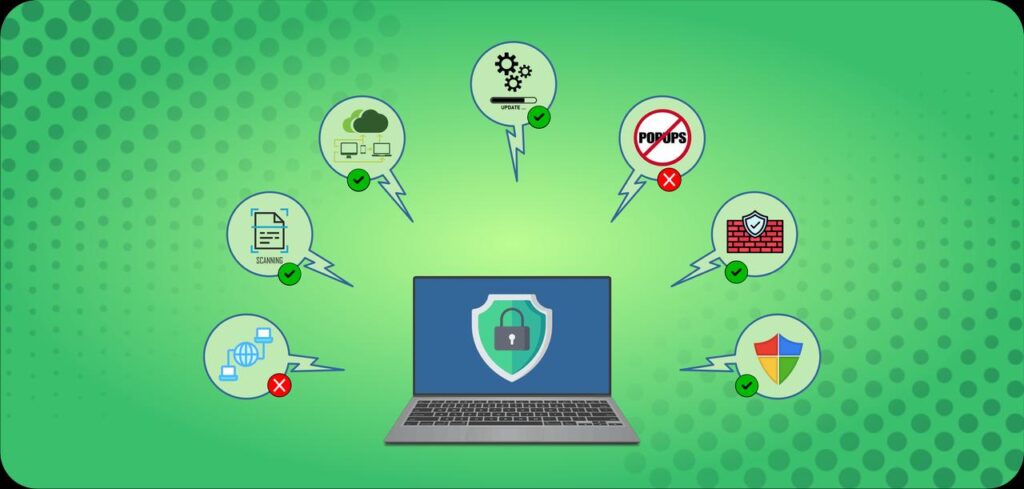How to Protect Your Computer from Virus?

The techniques used by cybercriminals to launch attacks have changed along with technology. Cybercriminals are always developing new ways to get into devices using cyberattacks like viruses. Understanding viruses and how to defend your devices from them is crucial. Let’s explore it to clean computer from virus: What is a Virus? Cybercriminals can enter your device and infect or damage your system via a virus, a sort of malware. To steal, corrupt, or remove whatever data and software they access, viruses may spread from one device to another. Viruses bind to your device’s programs to duplicate themselves. They spread while the compromised software is operating on your computer. Without your knowledge, cybercriminals use malware to slow down your systems and track your device activities. Detecting a virus on your device might be challenging since it remains silent until the compromised program is launched. What does a Computer Virus do? Some computer viruses are designed to damage programs, erase data, or reformat the hard drive to cause harm to your machine. Others simply duplicate themselves or overload a network with traffic, rendering all internet activity impossible. By using up memory and causing frequent failures, even less serious computer infections can seriously impair system performance. Peer-to-peer downloading websites were found to be used by the botnet virus Gameover ZueS in 2013 to spread ransomware and perpetrate banking fraud. Although there are still tens of thousands of computer viruses on the internet, they have changed their tactics and are now joined by various malware varieties such as ransomware, Trojans, and worms. How does a Computer get a Virus? Since computer viruses have existed for as long as personal computers have, virus creators are aware that the simplest way to spread a virus is always through human error. As a result, even if powerful antivirus software can successfully block the majority of online threats. It is powerless to stop users from clicking on malicious links or downloading compromised software on their computers. Keep in mind that you can be unintentionally allowing a viral program to infect your computer when you download data or programs from an unknown website. Malicious emails may also contain links that start an automatic download. How do Computer Viruses Spread? Networks, DVDs, email attachments, and external storage devices like USB sticks are just a few of the ways viruses can spread. Infected floppy disks were a typical way for early computer viruses to spread since device connections were much more restricted than they are now. Links between internet-enabled gadgets are common these days. This gives viruses plenty of opportunity for growth. The most popular way for computer viruses to spread is through malicious email attachments, according to the U.S. Cybersecurity and Infrastructure Security Agency. The majority of computer viruses protection, but not all of them, need a user to do something, such as clicking a link or turning on “macros,” to spread. Protect your Computer from Viruses You’ll likely use your computer for most of your work if you have a website. This means that there is an actual possibility that any files you upload to your website could also be infected if your PC is infected with a virus. This could result in your website failing, your web host taking it offline, or your users’ devices becoming infected as well. Here are some creative ways to protect your computer from viruses, to make sure this doesn’t happen. 1. Use an Anti-Virus Program Installing an anti-virus program, such as Norton, McAfee, Sophos, or Kaspersky, is the most crucial thing you can do to keep your computer clear of viruses, ransomware, and other malware. Avast and AVG are two free choices, however, the majority of them are premium options. These extremely advanced technologies will continuously defend your computer from a wide variety of attacks. They have to be in the background at all times. 2. Turn on your PC’s Firewall Firewalls are built into both Mac OS and Windows. By controlling network traffic, these creative techniques help safeguard your computer and the information and files kept on it. They perform this by preventing without permission and undesirable traffic, such as viruses and hacker attacks, from reaching your computer via the network. Verify that your firewall is turned on. 3. Keep Software Updated Many applications, including the operating system and all of the loaded software, will be running on your computer. These may have safety issues that let hackers or malware access the computer. Installing updates as soon as they become available will remove any vulnerabilities in the previous version, which is an easy approach to prevent this from happening. 4. Turn on Secure Browsing Anti-virus software frequently includes free secure browsing features. Their responsibility is to keep you away from websites that could damage your PC. Certain websites have been programmed to infect your computer as soon as your browser opens them. By blocking access to these websites, secure browsing will stop your browser from accessing them and will instead show a warning page. 5. Block Popups Cybercriminals also attempt to infect your computer using pop-ups. Some popups require a click to be activated, while others are made to steal login credentials and other private data. In other cases, you may become infected as soon as the pop-up appears. Naturally, not all pop-ups are harmful, and many websites use them to present offers and advertisements legally. However, it might be challenging to identify the harmful ones. Pop-up blockers can be installed as an add-on or are included in many browsers. 6. Don’t Download Software from Unsafe Sites Be extremely cautious about where you get software if you’re looking for a deal. Some scammers corrupt software, causing your computer to become infected when you download and install it. To increase the number of downloads, they frequently get copies of genuine, well-known software, change the programming with malware, and then promote it online for free or at a discount. Avoid using software sources you are not familiar with to prevent this. 7. Virus-Check External Drives Any external storage device, such as
